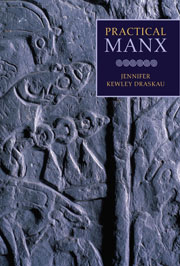Book contents
- Frontmatter
- Contents
- Preface and acknowledgements
- Abbreviations
- 1 Initial sound change
- 2 Nouns
- 3 Pronouns
- 4 Prepositions
- 5 The article
- 6 Adjectives and adverbs
- 7 Conjunctions
- 8 Numerals
- 9 Verbs
- 10 Phrasal verbs
- 11 The verb in use
- 12 Word order and sentence structure; word building
- 13 Dates and seasons
- 14 Emphasis
- 15 Spelling and pronunciation
- Gist English translations of recorded Manx conversations
- Glossary
- Select bibliography
7 - Conjunctions
- Frontmatter
- Contents
- Preface and acknowledgements
- Abbreviations
- 1 Initial sound change
- 2 Nouns
- 3 Pronouns
- 4 Prepositions
- 5 The article
- 6 Adjectives and adverbs
- 7 Conjunctions
- 8 Numerals
- 9 Verbs
- 10 Phrasal verbs
- 11 The verb in use
- 12 Word order and sentence structure; word building
- 13 Dates and seasons
- 14 Emphasis
- 15 Spelling and pronunciation
- Gist English translations of recorded Manx conversations
- Glossary
- Select bibliography
Summary
Manx employs both co-ordinating and subordinating conjunctions.
Co-ordinating conjunctions
The principal co-ordinating conjunctions in Manx are as (and), agh (but), ny (or):
as (and)
V'eh jeant feayr ec aer yn oie as ghow eh toshiaght dy chur reddyn my ner
He was chilled by the night air and beginning to notice things
[Nigel Kneale, ‘Curphey's Follower’, tr. Brian Stowell, Duillagyn 1, November 2005]Jeh reiltys niau lhig toiggal cooie ve ayd
As da dooyteilys ny cur arragh raad
Then know the truth of government divine
And let these scruples be no longer thine
[Thomas Parnell, The Hermit 194–195]agh (but)
Va graih aym urree – cha row niart aym er –
Agh ish gyn graih, nagh ren goaill tastey jeem.
I loved her – I couldn't help myself –
But she was without love for me.
[R. C. Carswell, ‘Ushag y tappee’, Shelg yn Drane 1994]ny (or)
Cha s' aym's vel mee er jannoo mie ny dyn
I don't know whether I've done well or not
[Ned Maddrell (1877–1974)]In the last example, in both Manx and English, only one single word follows the conjunction, so it doesn't look much like a real clause. But both Manx ‘ny dyn’ and English ‘or not’ in this context correspond to a full clause, meaning ‘or whether I have not done well,’ so ny counts as a co-ordinating conjunction.
- Type
- Chapter
- Information
- Practical Manx , pp. 95 - 104Publisher: Liverpool University PressPrint publication year: 2008



